
|   |

|   |
16th Raseshwar Saikia Barbayan Sattriya Award Festival - Tapati Chowdhurie e-mail: tapatichow@yahoo.co.in Photos: Arup Jyoti Kalita August 11, 2024 Sangeet Sattra held their 16th Raseshwar Saikia Barbayan Sattriya Award function and 56th Annual Festival of Dance and Music from July 8 to 10, 2024, at Srimanta Sankaradeva Kalakshetra. When Sattriya dance was declared as a classical dance form by SNA in 2000 CE, I was invited to the grand occasion. As a scholar and writer of dance, Raseshwar Saikia festival of dance in 2024 provided me with a good opportunity to fulfil my curiosity to see its progress since its initial days. Sattriya dance has grown in leaps and bounds. Steeped in Bhakti Raas, the dance form's mellow beauty takes hold of you, before you even realise it. An inner calm seems to invade your being as you hear the devotional Borgeets accompanied by the sweet sounds of the khol. Sangeet Sattra holds a place of honour among the Sattriya institutes. Established in Guwahati in 1968 by Raseshwar Saikia Barbayan, it offers valuable training in Sattriya dance and music. Sangeet Sattra is the first and foremost institution outside the Sattra premises. The institute has incorporated a systematic and scientific curriculum-based formal training in all aspects of Sattriya tradition. The institute founded by Raseshwar Saikia Barbayan - who was also its first Principal, while scholar poet and cultural historian of the North Eastern region in India, Dr. Maheswar Neog was the founder President - celebrated its 56th year. Presently, Sangeet Sattra is run by the two Saikia sisters, Ranjumoni and Rinjumoni - daughters of Raseshwar Saikia. 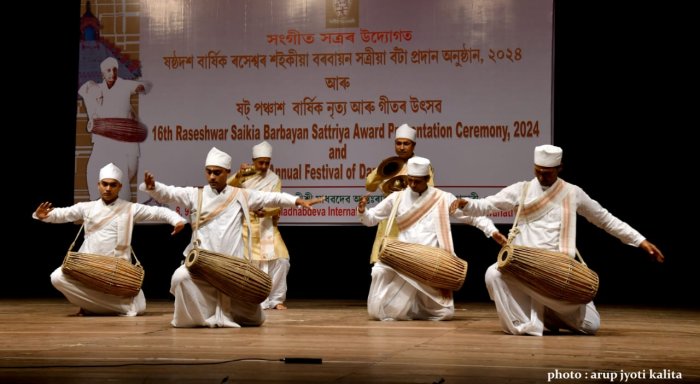 Sangeet Sattra commenced its evening program of dance and music with group Khol vadan recital by the students of Sangeet Sattra along with students from other institutes of Assam and Bangalore, USA and France, to a composition of Arunabh Jyoti, the illustrious son of Ranjumoni Saikia. The performance showcased some traditional rhythms of Gayan Bayan such as Poritaal, Rupak Taal, Dharamjyoti Taal, Chutkala Taal and Ektaal. 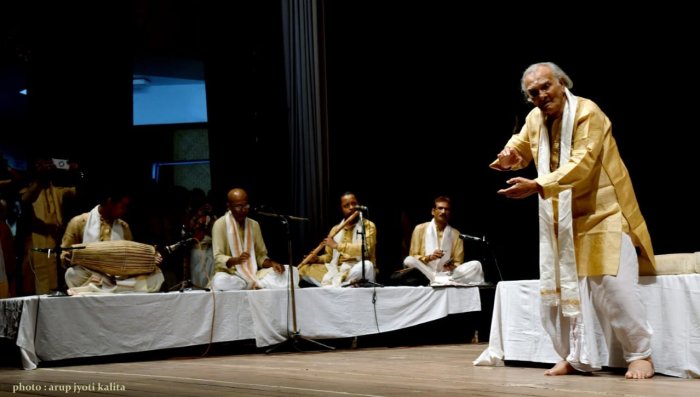 Nrityacharya Jatin Goswami Sattriya dance recital commenced with 91 year old Nrityacharya Jatin Goswami who started with Guru Vandana and went on to briefly tell the tale of Krishna's birth through abhinaya, immensely appreciated by the audience. The duo Partha Pratim Hazarika from New Delhi and Perrine Legoullon from France showcased tandava nritta through Nadhubhangi Nritya, incorporating both the Ramdani set to Suta Taal and Geetor Nach set to a variety of taals like Poritaal, Jaman Taal, Suta Taal, Melajyoti Taal and Chutkala Taal, typical items of the Sattriya repertoire, accompanied by the Borgeet "Braja Mangala" written by Mahapurush Madhavdeva. Through just a short piece of dance, the duo unfolded an amazing lot of Assam's Sattriya tradition. Soon after followed a beautifully composed Devadasi Nritya - a prayer dance - by the students of Sangeet Sattra. Aesthetically clad in long flowing billowing skirts, in typical Assamese costumes, the dancers practically glided through the stage evoking Bhakti Rasa. 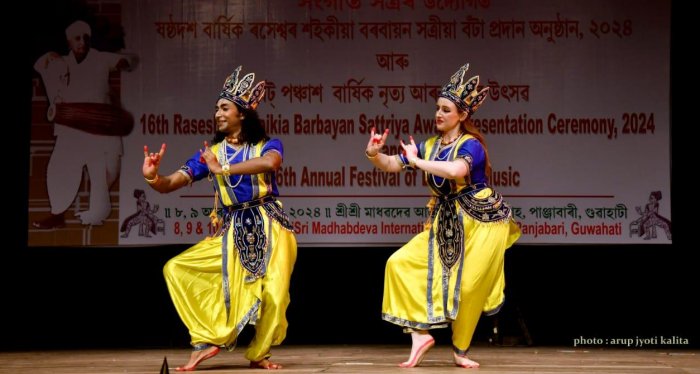 Partha Pratim Hazarika and Perrine Legoullon Invited guest Manipuri nritya practitioner Sudip Kumar Ghosh selected a piece where Bhakti saint Sri Chaitanya Mahaprabhu is playing Holi with all the devotees of Nabadwip. He led the rasikas to witness Mahaprabhu, play Holi in Vrindavan and evoke bhakti rasa through tears of intense bhakti sringar. Sudip helped the audience to recapitulate Sri Chaitanya as God himself and as a devotee alternately. Mahaprabhu soaked everyone with bhakti sringar. The concluding performance of the first evening was a Sattriya group recital by the senior students of Sangeet Sattra, that included Jollymoni Saikia, Bijita Goswami, Chitralekha Gogoi, Juri Das, Himashri Medhi, Elizi Ojah and Pragya Das. They regaled the audience with an exclusive abhinaya piece on the season of Sharad, when intense heat is not there and the evenings are mellow with people enjoying heart-warming toddy and nourishing food. Extracts of the piece was taken from Keligopal Naat of Srimanta Sankaradeva.  Sudip Kumar Ghosh 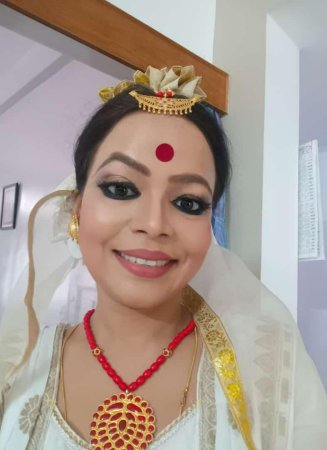 Usha Rani Baidhya The second evening started with a Borgeet of Srimanta Sankaradeva - "Nahi nahi ramaya bine.....", performed by renowned Borgeet artiste Sasanka Kumar Kalita and group. The Borgeet was performed to taal Xorubikham and raag Gauri. The first performance was led by Usha Rani Baidhya and her disciples. The piece evoked Chali dance in all its aspects. The piece was taken from the Hara Mohan chapter of Kirtan Ghosa of Sankaradeva. With Usha Rani in the lead role, the team performed commendably. A tabla - khol jugalbandi by Kaushik Konwar and Arunabh Jyoti Malakar followed soon after. The duo's jugalbandi starting with a 7 matra cycle composition, followed by the 8 matra cycle to finally culminating into a jugalbandi of bols created quite a ripple. A unique Sattriya-Kathak jugalbandi named as Nritya Angika was performed charmingly by the students of Mridanga and Sangeet Sattra. The performance showed a proper blending of Sattriya and Kathak with some unique drut laya rendition through the two forms held the audience under their sway. 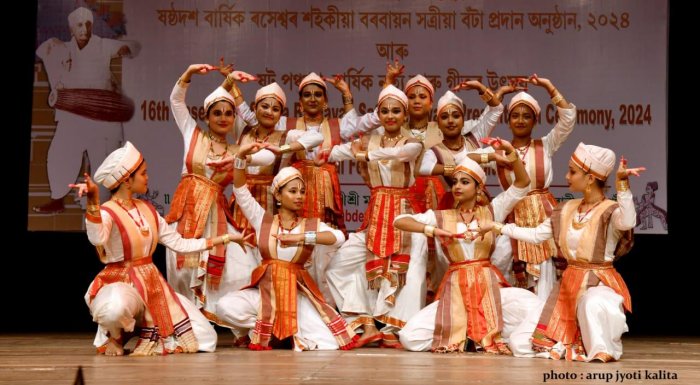 Students of Sangeet Sattra With joy, students of Sangeet Sattra performed Balyalila of Krishna Leela which expressed the deeds of little Krishna with his friends like grazing cows in the field, playing with his friends, Makhan Chor, etc. Sattriya duet by Anita Tamuly from Duliajan and her student Priyadarshini from USA made a mark with the performance of Chali dance with grace and elan. The abhinaya piece on the Borgeet "Alo hoi dekho hoi bihare soliya....." of Madhavdeva describing Krishna's innocent beauty as he played with the Gopa Balas was endearing. Ararajita Dawka, Tarali Das, Seetarani Hazarika and Dr. Saraju Hazarika started with a prayer dance, "Ami joto jiba..." followed by one among the 8 Chali nritya and concluded with a abhinaya on the Borgeet "Bahir hoiya ase dekho..." which described how lucky the gopabalak and the gopis are to get Krishna among themselves and glorified Krishna as Param Purush. The day ended with a Sattriya group by the students of Sangeet Sattra where they performed a Krishna Vandana followed by pure dance abhinaya "Kanai kina rupa dekha..." which described Sri Krishna's beauty. 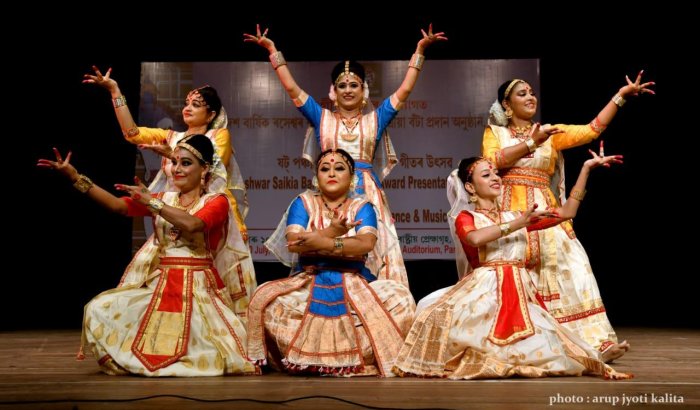 Sattriya dancers The concluding day started - as per tradition - with a Gayan Bayan, obeisance dance in praise of Krishna and pure dance and emoting through "Kanai kina rupa dekha" by Sangeet Sattra. Barpeta Sattra by Bipul Ojah and group performed the Purvaranga orchestra, while Sangeet Sattra students danced to the devotional Borgeet to taal Kharman and raag Maur (Mahur). Sattriya dancer Sukanya Deka was an added reward for the audience. "Krishna rupe daibokito" was a prayerful dance rendered with devotion. The next piece where the central theme was lasya was true to its name. Sukanya Deka was an epitome of grace. "Baleko Gopalo" written by Srimanta Sankaradeva during medieval times is as adorable today as it was centuries ago. Bedanta Bikash Dutta from Golaghat and Chandan Konwar from Moran schooled the audience about Naam Ghosa/Divine Verses written by Madhavdeva followed by the Rajagharia Chali Nritya and then they performed an abhinaya on the theme Rukmini. The extract was taken from the play Rukmini Haran of Sankaradeva. This was followed by a prayer and mati akhora (the grammar of Sattriya dance) by the students of Sangeet Sattra. Sattriya group Gayatri Konwar, Bijita Goswami, Chitralekha Gogoi, Kakali, Niharika and Rotipriya followed the same pattern-Vandana, pure dance and abhinaya. The same pattern was followed by the other groups. The devotional pieces performed were 'Totay', "Madhu danabo darana deva baran..." which talks about how Lord Vishnu killed the devil Madhu and rescued the deities. Later the abhinaya glorifies Lord Vishnu. Next was a Sattriya group performance by Bihpuria Sattriya Sangeet Vidyalaya from Lakhimpur taken from the play Keli Gopal. The last performance was by the students of Sangeet Sattra, who danced the Balya Charitra of Srimanta Sankaradeva (the Assamese saint-scholar, poet, playwright, dancer, actor, musician, artist and a social-religious reformer). All the dance and music performances of Sangeet Sattra were choreographed and composed by Ranjumoni Saikia, Rinjumoni Saikia, Dhrubajyoti Pathak, Juri Das, Mousumi Parasar, Arunabh Jyoti Malakar and Avantika Choudhury.  Tapati Chowdhurie trained under Guru Gopinath in Madras and was briefly with International Centre for Kathakali in New Delhi. Presently, she is a freelance writer on the performing arts. |